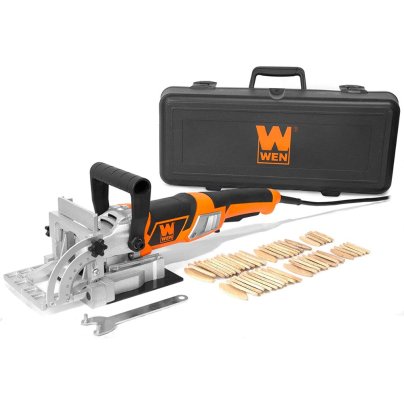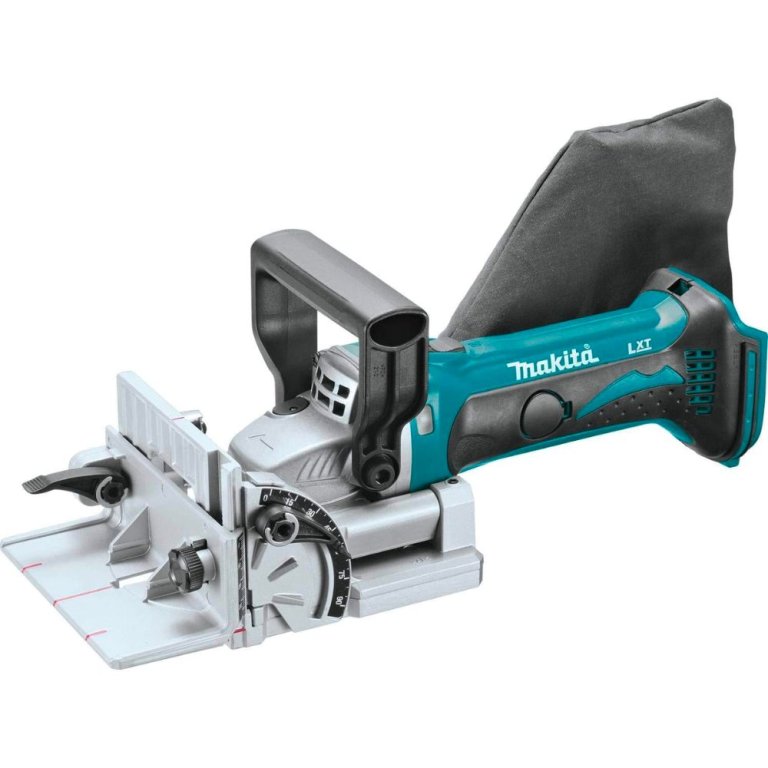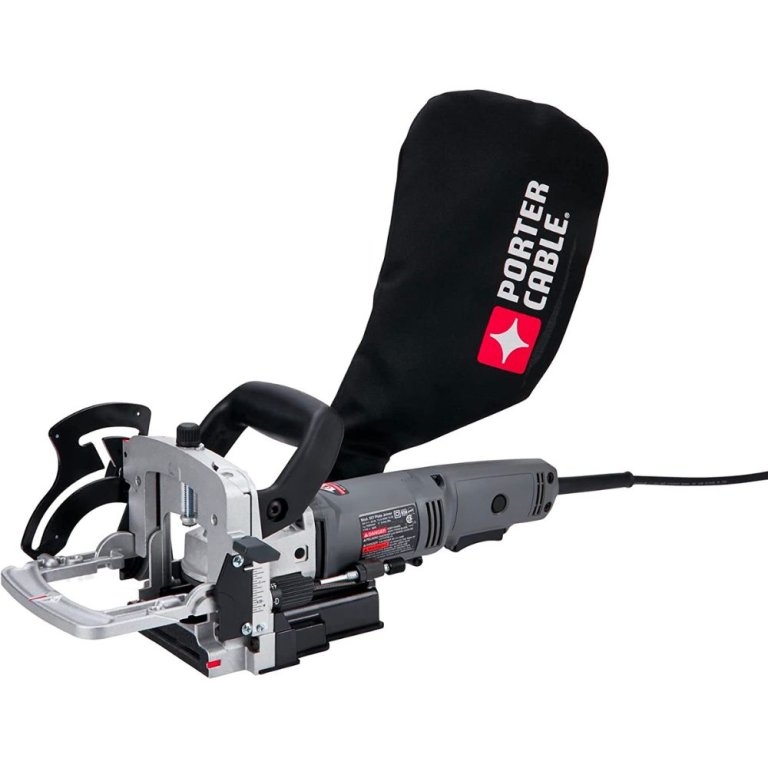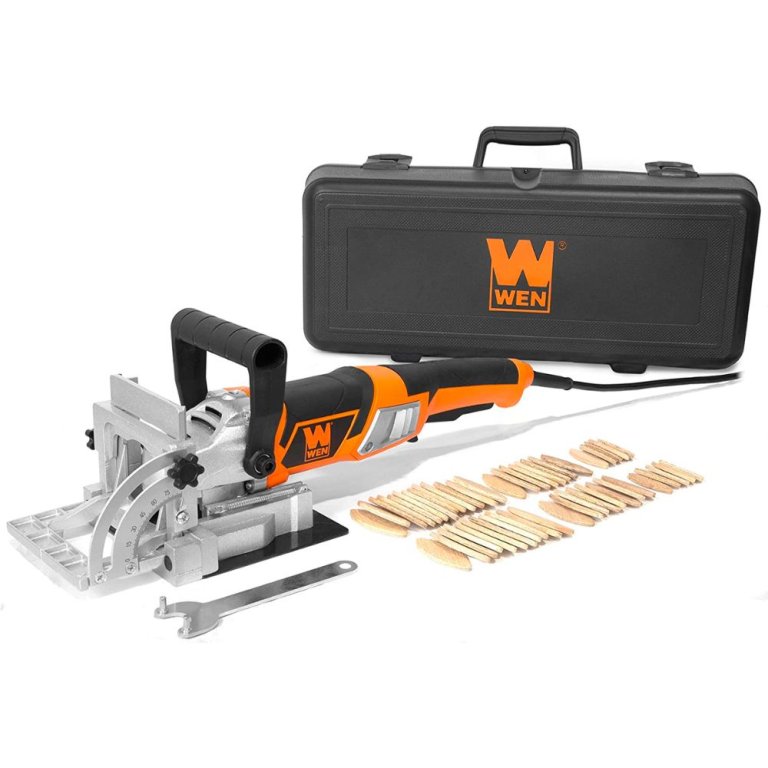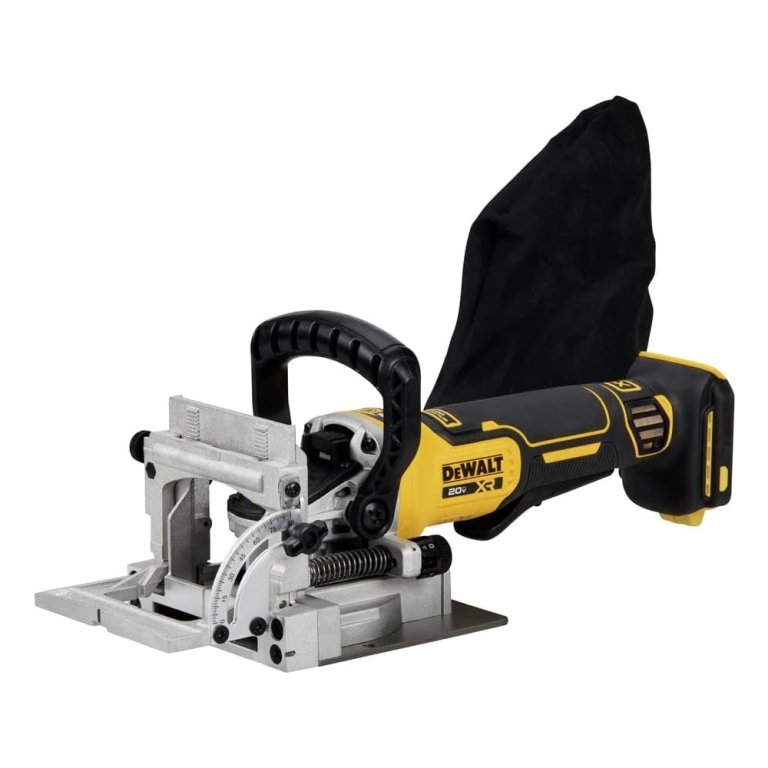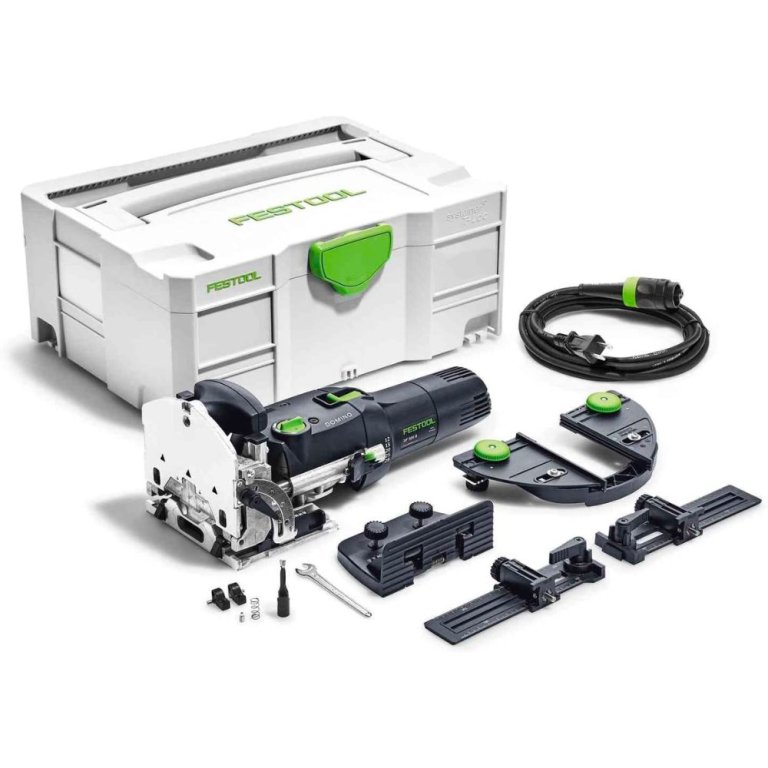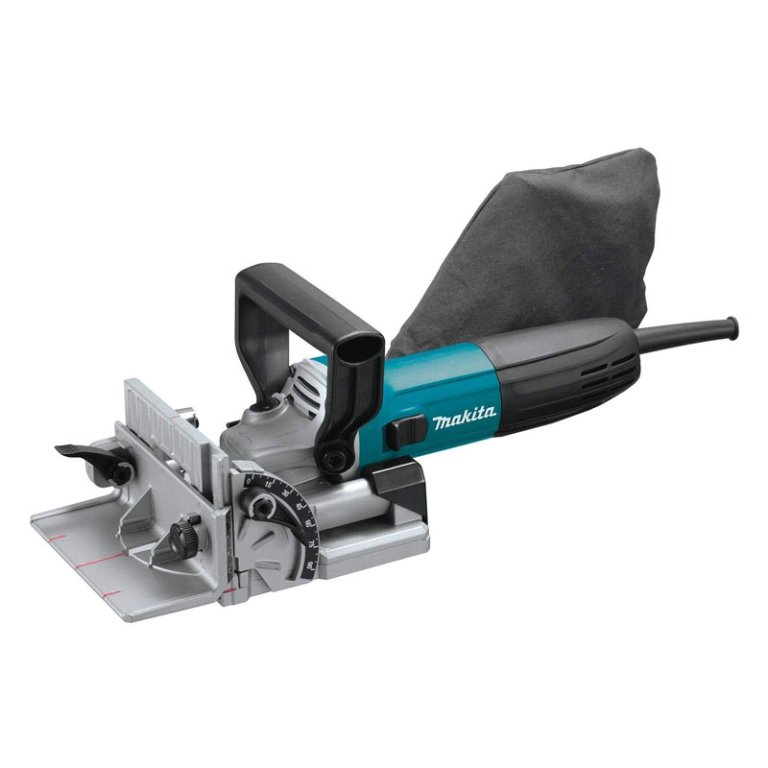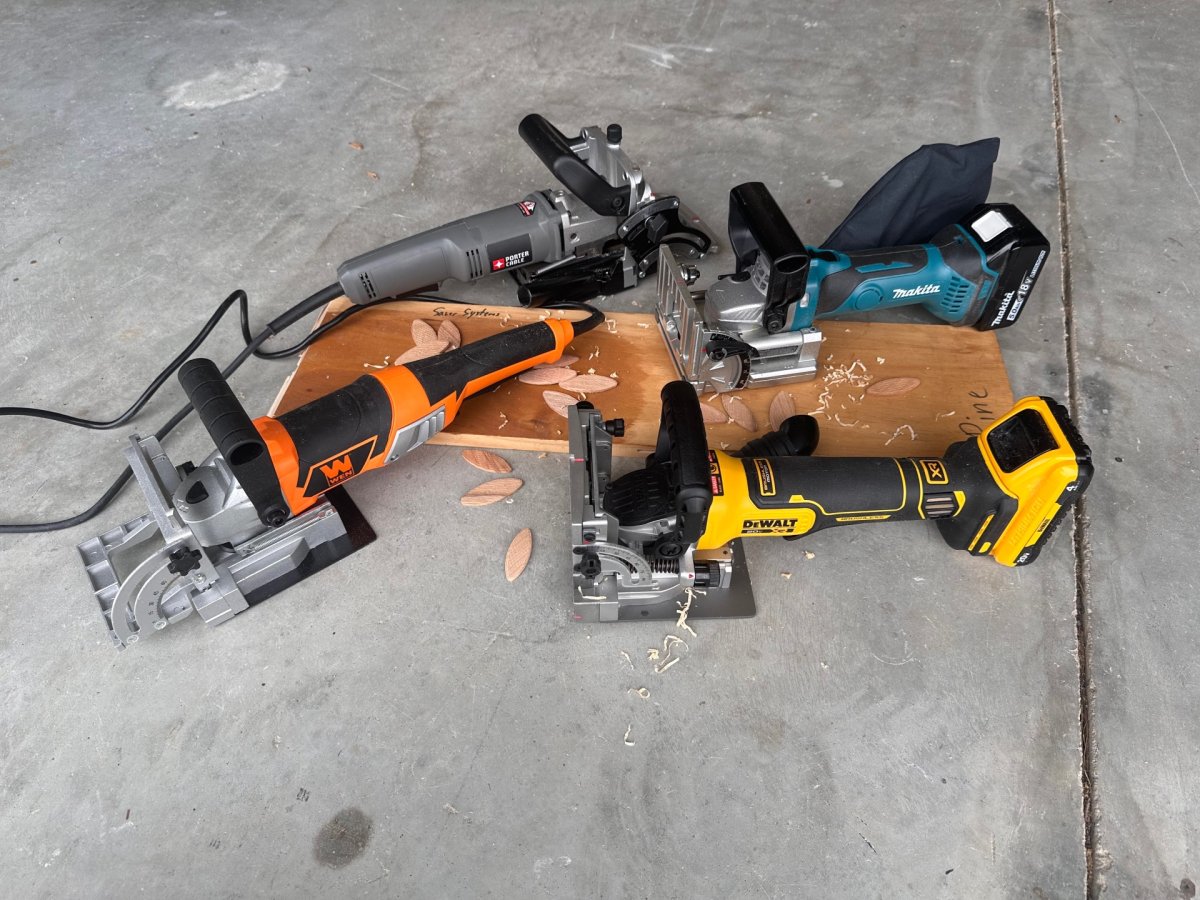
We may earn revenue from the products available on this page and participate in affiliate programs. Learn More ›
As a woodworker or DIYer, there are certain essential tools that, once the DIYer discovers them, help unlock their real potential, and among those tools is the trusty biscuit joiner. This power tool helps to create strong, seamless joints devoid of unsightly nail holes.
Whether you plan on gluing up a new worktop for a shop bench or building a bookshelf from scratch, the right biscuit joiner can help. These handy tools use small circular saw blades to cut slices in two pieces of wood, allowing woodworkers to insert a biscuit (a small, football-shaped chunk of compressed wood) in the two slots to create a solid joint. The glue-covered biscuit then expands, locking the two boards together and creating an incredibly strong joint that glue alone can’t match.
Drawing from our experience with a variety of tools, we selected seven top biscuit joiners, each designed and priced for DIY woodworkers, and we tested four of them. We found the Makita XJP03Z to be the best of the bunch, due largely to its convenient cordless design and ability to effortlessly slice into wood. Read on to learn the factors and features to consider when shopping for the best biscuit joiner and to find out why we consider the following models to be the best on the market.
- BEST OVERALL: Makita XJP03Z 18V Lithium-Ion Cordless Plate Joiner
↓ Jump to Review - RUNNER-UP: Porter-Cable 557 7-Amp Deluxe Plate Joiner Kit
↓ Jump to Review - BEST BANG FOR THE BUCK: Wen JN8504 8.5-Amp Plate and Biscuit Joiner
↓ Jump to Review - BEST CORDLESS: DeWalt DCW682B 20V Max XR Cordless Biscuit Joiner
↓ Jump to Review - BEST ALTERNATIVE JOINER: Festool 574432 Domino Joiner DF 500 Q-Set
↓ Jump to Review - ALSO CONSIDER: Makita PJ7000 Plate Joiner
↓ Jump to Review
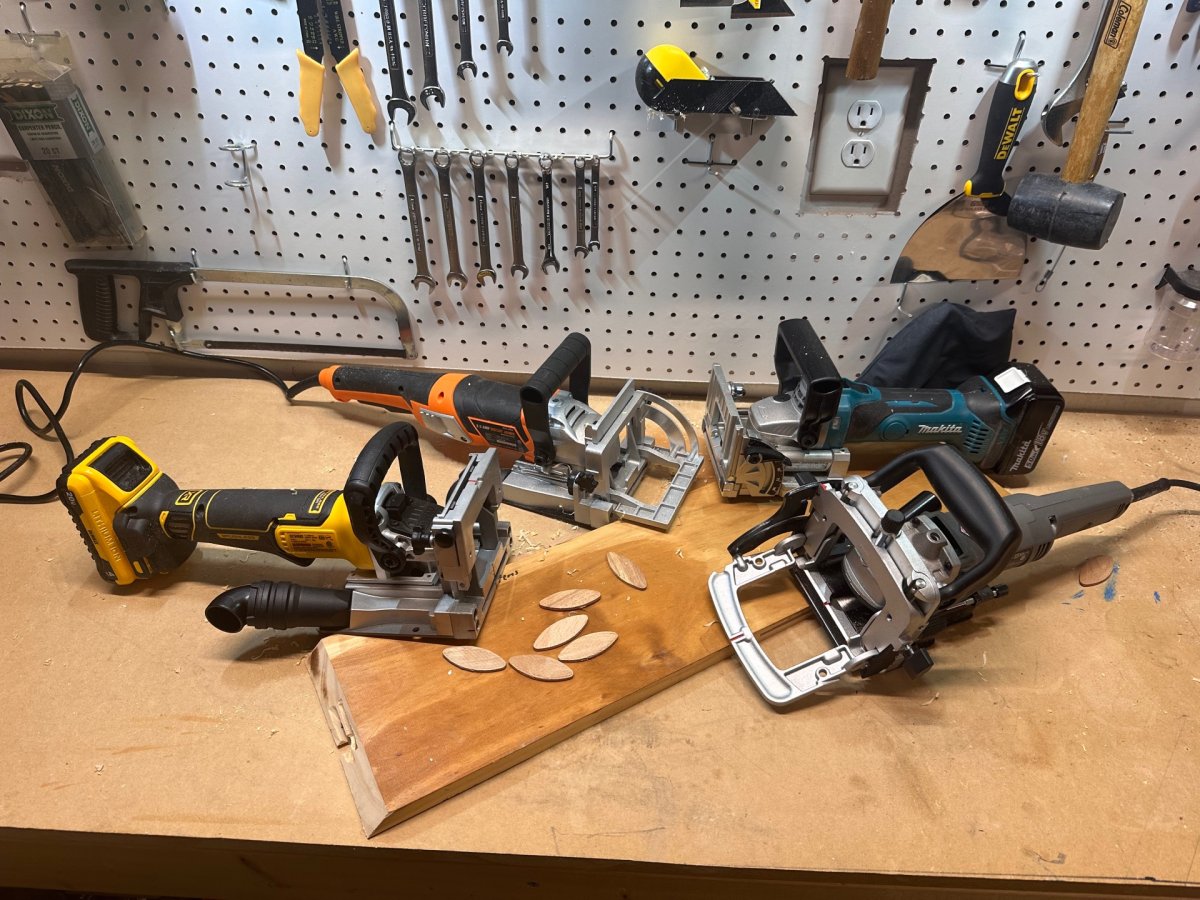
| Power Source | Biscuit Size | Handle type | |
| Makita XJP03Z | 18V battery | #0, #10, and #20 | Barrel |
| Porter-Cable 557 | Corded | #0, #10, and #20 | Barrel |
| Wen JN8504 8.5-Amp Plate and Biscuit Joiner | Corded | #0, #10, and #20 | Barrel |
| DeWalt DCW682B 20V Max XR Cordless Biscuit Joiner | 20V battery | #0, #10, and #20 | Barrel |
| Festool 574432 Domino Joiner DF 500 Q-Set | Corded | Uses Dominoes with 5, 6, 8, and 10 millimeter diameters | Barrel |
| Makita PJ7000 Plate Joiner | Corded | #0, #10, and #20 | Barrel |
Our Top Picks
The following list includes some of the best biscuit joiners available for woodworking projects. Whether you’re a beginner, a pro woodworker, or someone with a skill set that lands in between, you’re likely to find a quality tool for your workshop here.
Best Overall
Makita XJP03Z 18V Lithium-Ion Cordless Plate Joiner
What We Like
- Makes clean, precise cuts
- Easy to make adjustments to the fence
- Great build quality
What We Don’t Like
- Lacks safety shut-off features
Specs
- Power source 18V battery
- Biscuit size #0, #10, and #20
- Handle type Barrel
Our Ratings: Ease of Use 5/5; Accuracy 4.5/5; Value 4.5/5
Makita’s XJP03Z offers impressive performance and build quality in a convenient cordless design. This biscuit joiner uses Makita’s 18V LXT lithium-ion battery system, which allows it to produce up to 320 cuts (or 160 joints) on a single charge. Its motor generates an impressive 12,000 RPM, which slices into boards with minimal effort. And since the tool produces very little vibration, we were able to produce precise and accurate cuts. There’s also a blade break that stops the blade quickly, which is a nice safety feature.
The XJP03Z has six depth settings with positive stops for #0, #10, and #20 woodworking biscuits. A rack-and-pinion vertical fence system makes dialing in precise settings for various board widths easy. The fence has a miter range between 0 and 90 degrees, with a positive stop at 45 degrees.
The Makita has a sturdy, durable feel with a molded rubber grip that’s easy to control while making cuts, and a housing and fence that’s built to take beating.
Blade changes were also a breeze with the XJP03Z thanks to the design of its shoe. Unlike other biscuit joiners that required us to remove multiple screws to take off the shoe, the XJP03Z biscuit joiner tool uses a single knob you can loosen with your fingers.
The XJP03Z is available for purchase as a set with a battery or as a stand-alone tool for those who already own a battery for other Makita tools.
What our tester says: “The XJP03Z sliced effortlessly into softwoods and hardwoods alike with very little vibration or hesitation, which made it easy for me to make accurate cuts.”—Tony Carrick, Product Reviews tester and writer
Get the Makita biscuit joiner (tool only) at Amazon or The Home Depot.
Runner-Up
Porter-Cable 557 7-Amp Deluxe Plate Joiner Kit
What We Like
- Broad fence range of 0 to 135 degrees
- Makes precise, clean cuts
- Durable build quality
What We Don’t Like
- Heavy overall weight
- Pricey for a corded tool
Specs
- Power source Corded
- Biscuit size #0, #10, and #20
- Handle type Barrel
Our Ratings: Ease of Use 4.3/5; Accuracy 4/5; Value 3.7/5
Cabinetmaking requires a lot of joinery, and dense hardwood plywood can be tough on a biscuit woodworking joiner. For those situations, consider the Porter-Cable plate joiner kit. It features a wide fence angle range, multi-position depth stop, and a 7-amp motor that runs at 10,000 RPM to bore through dense plywood over and over again.
Power Cable’s biscuit joiner sets itself apart with its versatility. Unlike other biscuit joiners that have fences that are limited to a range of 90 degrees, the Porter-Cable’s fence tilts from 0 to 135 degrees, allowing users to create catty-corner cabinets and face frames without setting up complicated jigs or strange angles. It also has seven depth stops, handling #0, #10, and #20 biscuit sizes.
The Porter-Cable performed well in testing, making clean cuts through our test boards. That said, it did produce more vibration than the DeWalt and Makita biscuit joiners we tested. There were also some notable differences in quality. The Porter-Cable biscuit joiner uses a screw adjuster for the fence as opposed to a more precise rack-and-pinion adjuster, and it lacks the ergonomic handle and rubberized grip found on the DeWalt and Makita biscuit joiners we tested. Weighing over 10 pounds, the Porter-Cable biscuit joiner is also one of the heftier biscuit joiners we tested, which made it somewhat cumbersome when setting up cuts.
The Porter-Cable biscuit joiner is very similar in price to the Makita and DeWalt, even though it’s a corded tool.
Get the Porter-Cable biscuit joiner at Amazon or Rockler.
Best Bang For The Buck
Wen JN8504 8.5-Amp Plate and Biscuit Joiner
What We Like
- Far more affordable than most biscuit joiners
- Comes with a handy carrying case
- Wide range of fence adjustments
What We Don’t Like
- Less cutting power and precision
- Cheaper build quality
Specs
- Power source Corded
- Biscuit size #0, #10, and #20
- Handle type Barrel
Our Ratings: Ease of Use 3.8/5; Accuracy 3.5/5; Value 4/5
DIYers looking to spend as little as possible on a new biscuit joiner might want to consider the Wen JN8504. It costs a fraction of other biscuit joiners cost, yet it still boasts a powerful 8.5-amp motor with a cutting speed of up to 10,000 RPM. It comes with several biscuits, a wrench for blade changes, and a plastic carrying case.
This model features an adjustable fence as well as an angle gauge that adjusts between 0 and 90 degrees (though there aren’t any positive stops). It has an inline handle and dust extraction as well as adjustable depths that accommodate #0, #10, and #20 biscuits.
Wen’s biscuit joiner won’t rival the top models on this list. With its slower blade speed, it doesn’t produce the same clean and precise cuts as the models we tested that cost four times its price. It’s also the heaviest biscuit joiner we tested, weighing over 11 pounds. And although its fence system is easy to adjust, it lacks the ability to dial in more precise measurements. That said, it was good enough to execute edge-to-edge, T-joint, face-frame, and mitered-edge joinery in various thicknesses of wood.
The Wen does come with a carrying case that’s handy for storing it when not in use. While this biscuit joiner won’t make the grade for more serious woodworkers, it’s a great option for those who may only need one every now and then.
Get the Wen biscuit joiner at Amazon, Lowe’s, or The Home Depot.
Best Cordless
DeWalt DCW682B 20V Max XR Cordless Biscuit Joiner
What We Like
- Lightweight cordless design
- Excellent build quality
- Powerful with little vibration when running
What We Don’t Like
- Difficult to change the blade
Specs
- Power source 20V battery
- Biscuit size #0, #10, and #20
- Handle type Barrel
Our Ratings: Ease of Use 4.5/5; Accuracy 5/5; Value 4.7/5
DeWalt’s MAX XR business joiner lives up to the quality and performance we expect from the yellow and black brand. This member of DeWalt’s pro-focused XR line boasts a brushless motor that’s powered by a 20-volt lithium-ion battery.
The DCW682 is well designed. A pressure trigger that runs the entire length of the handle is easy to access while also adding an extra layer of safety. A single knob loosens the miter fence, and the fence slides easily and comes equipped with an easy-to-see arrow for setting precise angles, all of which makes setting up the proper angle for mitered joints a quick and easy process. Adding to this precision is a rack-and-pinion fence that made it easy to dial in precise settings for various board thicknesses.
The DeWalt biscuit joiner is powerful, cutting easily into wood boards with minimal vibration. It’s also one of the lightest biscuit joiners we tested, making it one of the most comfortable to use among the tools we tested. The DCW682 also comes equipped with a larger-than-average dust bag, which was effective at capturing the majority of sawdust produced by each cut we made.
Our only gripe is with blade changes. In order to change the blade, you need to remove the four Torx head screws that secure the shoe over the blade, which is a more time-consuming process than other units we tested that offer tool-free access to the blade.
What our tester says: “I love how easy it is to make adjustments to the fence and cutting depth with the DCW682. It’s one of the easiest biscuit joiners I’ve used.”—Tony Carrick, Product Reviews tester and writer
Get the DeWalt biscuit joiner at Amazon or Lowe’s.
More Great Options
Along with the four biscuit joiners we tested, we also recommend the following models, which include a higher-end model for serious woodworkers and another more affordable corded option.
Best Alternative Joiner
Festool 574432 Domino Joiner DF 500 Q-Set
What We Like
- Domino mortises provide more bonding surface area than biscuits
- Several depth adjustments
- Has multiple angle stops
What We Don’t Like
- Festool Dominoes aren’t available everywhere
Specs
- Power source Corded
- Biscuit size Uses Dominoes with 5, 6, 8, and 10 millimeter diameters
- Handle type Barrel
The Festool 574432 Domino joiner might not exactly be a biscuit joiner, but it’s one of the best tools for similar joinery in furniture and woodworking. The Domino uses Festool-specific hardwood tenons, which are candy-bar-shaped inserts that take the place of traditional biscuits. Instead of a circular blade, it has a drill bit-like spiral cutter to bore the mortises. This allows users to adjust the depth to prevent it from poking through a workpiece while still offering plenty of surface area for glue.
Despite the unconventional joinery method, the Domino does have the flexibility of other biscuit joiners, with a few extras. Users can adjust the fence angle between 0 and 90 degrees, with stops at 22.5, 45, 67.5, and 90 degrees—two more stops than many of its competitors. It has multiple height adjustments and depth settings for fast, easy, and accurate adjustments. Festool is also known for employing effective dust extraction.
This kit comes with a carrying case and several guides and fences. Shoppers should know, however, that the floating tenons (Festool calls them Dominoes) may not be as readily available as biscuits.
Get the Festool biscuit joiner at Amazon.
Also Consider
Makita PJ7000 Plate Joiner
What We Like
- Powerful enough to generate 11,000 RPM
- Weighs just 5.5 pounds
- Barrel-shaped handle allows for plenty of accuracy
- 6 depth adjustments
What We Don’t Like
- 5.6-amp motor is on the less powerful side
Specs
- Power source Corded
- Biscuit size #0, #10, and #20
- Handle type Barrel
If you’re looking for an all-around biscuit-joiner tool that really holds its own, check out the Makita plate joiner. This barrel-handled biscuit joiner has a 5.6-amp motor, and while that is on the lower end compared to some competitors, it produces speeds up to 11,000 RPM for dense hardwoods. It weighs just 5.5 pounds, has a maximum cutting depth of ¾ inch, and includes a carrying case as well as a 4-inch carbide-tipped blade.
The PJ7000 offers lots of adjustability. The fence has a rack-and-pinion vertical adjustment that allows users to dial the joiner into the perfect height. The fence also adjusts between 0 and 90 degrees, with positive stops at 0, 45, and 90. The PJ7000 has six different depth adjustments, with one-touch stops for standard biscuit sizes of #0, #10, and #20.
Get the Makita PJ7000 biscuit joiner at Amazon or The Home Depot.
Jump to Our Top Picks
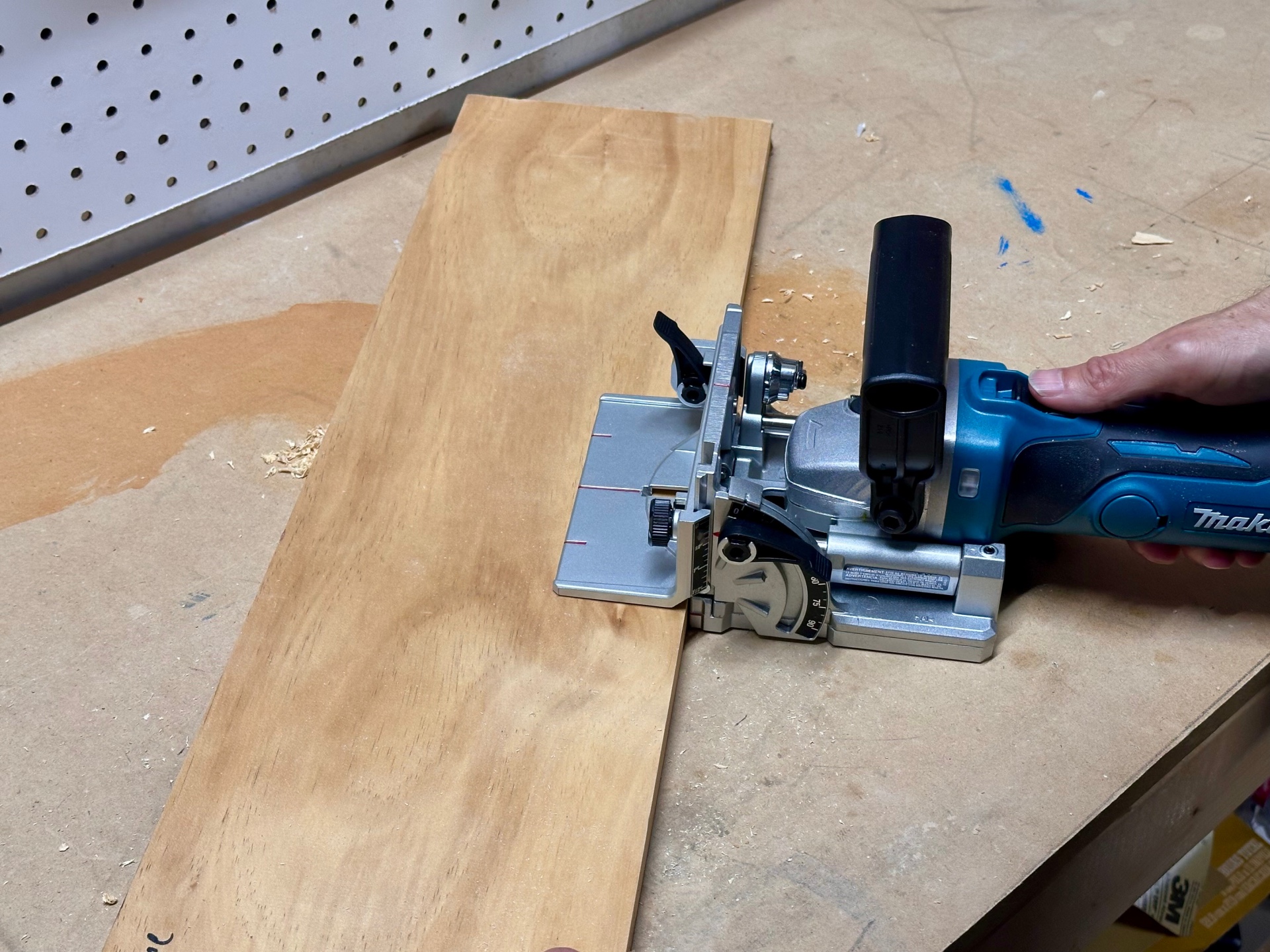
How We Chose and Tested the Best Biscuit Joiners
The best biscuit joiners tend to have a high power output, adjustable settings, and added attachments and accessories. They should also be easy to use. We considered all this while making our selections.
Our top picks come with powerful motors of 5.6 to 8.5 amps for speeds between 10,000 and 12,000 revolutions per minute (RPM). This power output is aided by adjustable angles and depths for quick and clean cutting. Many of these picks have 0- to 90-degree angles, with a select few topping out at 135 degrees. Plus, some of these top picks come with multiple preset depths.
We put four of the biscuit joiners through a series of tests, using them to cut biscuit holes into hardwoods and softwoods of two different thicknesses. As part of our testing, we made a series of cuts at different angles to test each model’s miter fence and depth adjusters. We noted how easy it was to set up cuts and make adjustments to the biscuit joiner, and how precisely each one executed cuts. For the products we didn’t test, we based our selections on specifications and user reviews.
| Testing Stats | |
| Products tested | 4 |
| Time spent testing | 6 hours |
| Tests performed | 4 |
| Price range | $60 to $300 |
| Ease of Use | Accuracy | Value | |
| Makita XJP03Z | 5 | 4.5 | 4.5 |
| Porter-Cable 557 | 4.3 | 4 | 3.7 |
| Wen JN8504 8.5-Amp Plate and Biscuit Joiner | 3.8 | 3.5 | 4 |
| DeWalt DCW682B 20V Max XR Cordless Biscuit Joiner | 4.5 | 5 | 4.7 |
What to Consider When Choosing a Biscuit Joiner
Once a DIYer gets their hands on a good biscuit joiner, they might wonder how they ever finished woodworking projects without one. They’ll no doubt come to rely on it a lot, so choosing a quality model is key. Here’s what to keep in mind when shopping for the best biscuit joiner.
Size and Weight
Usually, the larger and heavier the wood biscuit cutter, the better the quality of its parts, and a bruiser of a biscuit joiner will likely have a heavy-duty motor and high-quality slides (which guide the blade while it cuts to provide consistent results). However, a heavy biscuit joiner or a super high-end tool isn’t necessary or even ideal for everyone. There are plenty of mid-range options weighing around 5 or 6 pounds—about half the weight of a high-end model—that will do the trick for many users.
Determining whether a burly biscuit joiner is necessary will come down to the types of projects you plan on doing and how often you’ll use the joiner. For the overwhelming majority of DIYers, a mid-range biscuit joiner will handle materials like oak and maple without issue. Those working in a cabinet shop and putting a joiner through its paces daily should consider the heavier-duty options.
Corded vs. Cordless
As with all power tools, the corded-versus-cordless debate exists in the biscuit-joinery world. Deciding on a style often just comes down to personal preference.
Almost all biscuit joiners are corded. Since most woodworking projects take place in a workshop, there’s usually power readily available. Also, it’s not typical to be climbing a ladder or working under a cabinet with a biscuit joiner, so portability isn’t really a consideration.
Biscuit joinery is quite taxing on a battery, so most manufacturers haven’t dived into cordless joinery. However, there are a few cordless biscuit joiners available. These can be quite handy during projects like kitchen remodels, where the user might need to join two sections of wooden countertops and would prefer not to set up an extension cord.
Power and Speed
Biscuit joiners need to be stout power tools with tough parts and plenty of power and speed. While it might not take much power to bore a hole in pine or cedar, plunge-cutting a section of hickory or walnut can be a challenge.
The most important power-related factor to consider when shopping is a biscuit joiner’s amperage rating. Amperage refers to the current load a motor can handle before its parts start to fail. This has much to do with the quality of individual components inside the tool and how well it can cool itself while running. Ideally, look for a model with 5 to 7 amps.
When it comes to actually getting the work done, speed matters as well. The faster the motor, the faster it can spin the blade and cut a biscuit slot. Look for models with RPM ratings between 8,000 and 10,000 for general use.
Biscuit Size
Biscuit joiners use biscuits to join workpieces together. When the user inserts a glue-covered biscuit into a slot, it locks in to join two workpieces as one. Biscuits come in small, medium, and large sizes (#0, #10, and #20, respectively). To accommodate different-size biscuits, most joiners have settings that adjust for deeper or shallower cuts, some cutting as deep as ¾ inch; other models may require a blade change.
While biscuit size might not be a factor when shopping for a biscuit joiner, it can be important while working. For example, bookshelves and countertops might require a lot of gluing surface—and a bigger biscuit—while only a smaller biscuit might fit in a cabinet face frame.
Blades
Although biscuit joiners use circular-shaped saw blades, they’re quite a bit different than the blades found in a miter, table, or circular saw. They’re thicker, have fewer teeth, and are much smaller in diameter.
Burrowing a spinning blade into dense hardwoods over and over again builds up quite a bit of heat and pressure, so blade material and longevity matter. Most biscuit joiner manufacturers use carbide-tipped blades, as they stay sharper longer than a lower-end steel blade, particularly for denser materials like walnut and hickory. They also hold up better to the speeds of high-end biscuit joiners.
Cutting Angle and Depth
One feature most woodworkers appreciate about biscuit joiners is the tools’ versatility. The adjustable cutting angles provide the ability to cut slots in a wide range of situations. While edge joining two boards is the most obvious use for biscuit joiners, they can also bore biscuit slots for mitered corners and angled joinery or slots in the field of a workpiece for shelves or other uses. This is thanks to their adjustable fences, which users can set for a particular angle to bore an accurate slot.
Adjustable cutting depth is also an important feature. Swapping between preset depths allows users to use different biscuit sizes quickly without worrying if the joint will be tight or hold enough glue.
Handle Type
When choosing the best biscuit joiner for a workshop, consider handle preference. There are two main styles: barrel handles and D-shaped handles.
Barrel-style handles can facilitate precise boring, so they’re better for control. With these models, the hand is in line with the slot being cut, making it easier to stay steady and bore an accurate slot. There are also many models with top-mounted handles to steady the tool even more.
D-shaped handles are less accurate but more comfortable. The hand’s upright orientation tends to feel more natural, so it’s easier to push. However, the hand will be higher than the blade, so it’s possible to wobble and make a sloppy cut.
Additional Features
Biscuit joiners may include some additional features that can make storage simpler and cleanup easier.
A sturdy box will keep a biscuit joiner secure when it’s not in use. Many manufacturers package their tools in hard plastic containers that can store a joiner, a few biscuits, and other small items. These cases also make it a cinch to stack tools on a shelf or under a workbench.
As the user bores slots with a biscuit joiner, they can make a mess with sawdust and wood chips. The best biscuit joiners come with bags that attach to the exhaust port, catching most of these particles before they hit the ground or air.
Safety Tips for Using a Biscuit Joiner
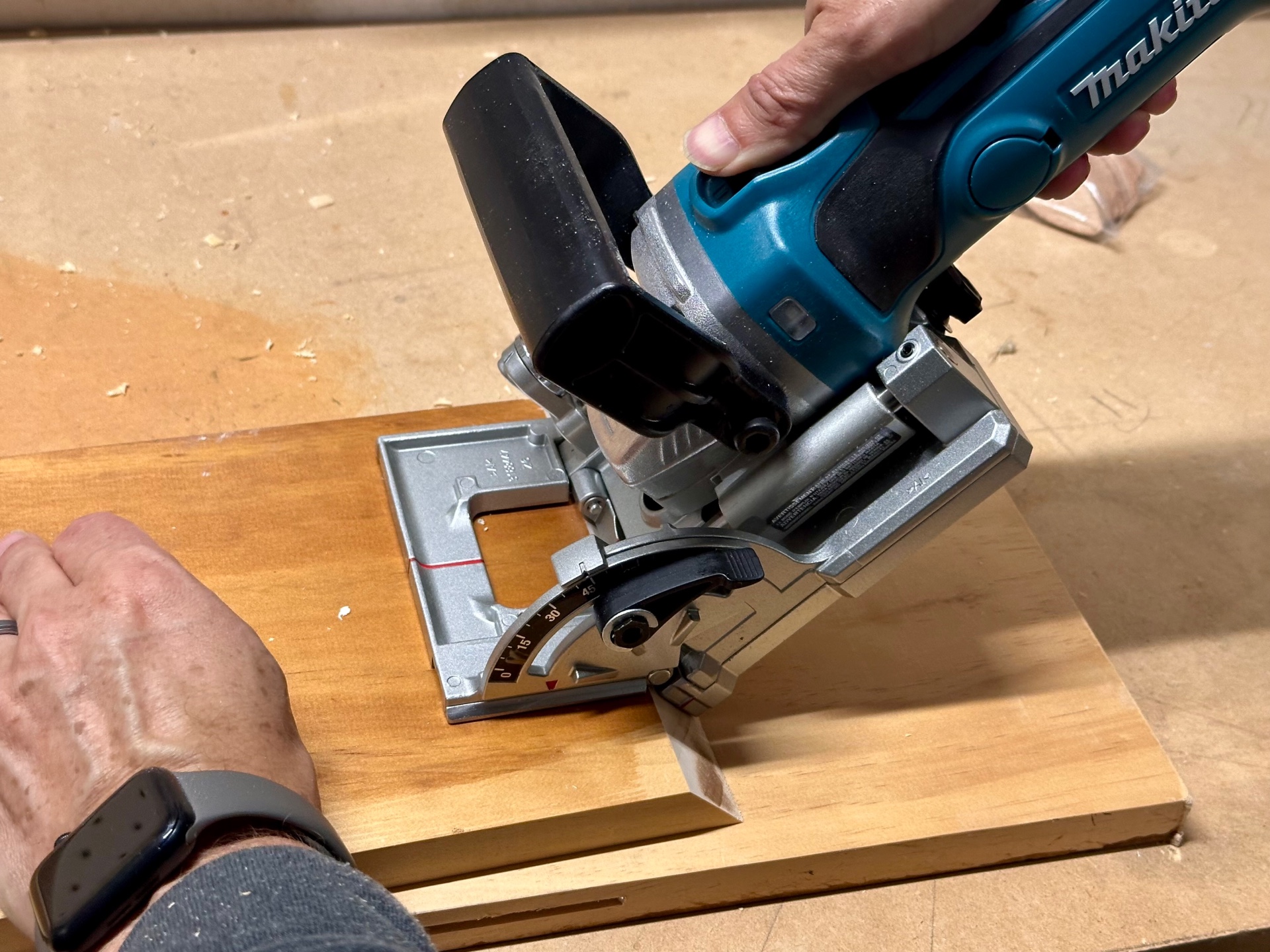
In general, biscuit joiners are safe power tools—but that could inspire some false confidence. As users become more comfortable using theirs, they might feel they can hold the workpiece with one hand while operating the tool with the other. It’s best to avoid this temptation, as the front lip of the board could lift, potentially causing the blade to strike a hand. Instead, clamp the workpieces to a workbench for a stable base.
Before cutting slots for biscuits, ensure that there are no nails, knots, or other obstructions where the joiner will be cutting. In most cases, the blade will simply cut through these obstructions, dulling the blade a bit. However, there is potential for the biscuit joiner to send a chunk of the obstruction flying with enough speed to cause injury.
Biscuit joiners can produce a lot of dust. While a dust-collection system helps reduce the amount of sawdust, it can’t get it all. Be sure to wear a mask to avoid breathing in airborne dust and safety glasses to keep your eyes protected. This safety gear is especially important when working with plywood and medium-density fiberboard (MDF). The glues and chemicals used in their manufacturing can be particularly irritating to the lungs and eyes.
- Clamp the workpiece to a bench to avoid potentially striking a hand with the biscuit joiner.
- Ensure the workpiece is free of obstructions like nails and knots before cutting biscuit slots.
- Wear safety glasses and a mask for protection from sawdust.
FAQs
While you may be excited about getting started with a new biscuit joiner, if you still want more info, refer to the answers to these frequently asked questions regarding biscuit joiners and how they work. If you don’t see the required answer here, reach out to the manufacturer’s customer service department and speak with a representative.
A good rule of thumb is to use a biscuit every 6 to 12 inches. For weight-bearing projects like shelves and countertops, 6 inches is best to provide support.
You can use biscuits with a range of wood-based products: Hardwoods, softwoods, plywood, MDF, and even laminated particleboard can work with a biscuit joiner.
For many woodworkers, yes. Biscuit joiners allow the user to join pieces of wood without the use of nails or screws that create unsightly holes, which is crucial when building furniture and other finish pieces of carpentry. And since it isn’t difficult to learn how to use a biscuit joiner, these tools are useful for even novice woodworkers.
Biscuit joiners require some level of precision for effective use. While biscuit joints are strong, they aren’t as strong as other types of woodworking joinery, such as half-lap and mortar and tenon joints.
A biscuit joint should be at least 2 inches from the edge or corner of a workpiece. You’ll also want to space each biscuit about 2 to 3 inches apart.
To maintain your biscuit joiner, regularly clear out any sawdust that has collected in and around the blade. Also, regularly check the blade for damage or build-up from pitch, especially if using the joiner with hardwoods, which can be harder on the blade.
Meet the Tester
Tony Carrick is a freelance writer specializing in home improvement, landscaping, technology, home security, and design. His articles have been featured on such sites as Popular Mechanics, Futurism, SFGate, Pro Tools Review, and more. Tony has conducted rigorous product testing on everything from power tools to home security systems to backyard grills. With each review, his goal is to help readers determine whether a product meets their needs and if it is or isn’t worth its price tag.
Additional research provided by Tom Scalisi.


